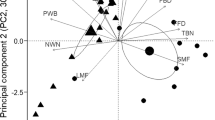Summary
Taxa of the Carex flava group in Switzerland show a trend towards increased colonizing ability (r-selection). High colonizing ability is correlated with a large fundamental but a small and discontinuous realized niche. It is argued that r-selected species with wide niches should be monomorphic with generalists rather than polymorphic with specialists since they have small effective population sizes in which high genetic variability cannot be maintained. The most r-selected taxon of the group, C. viridula spp. viridula, has indeed the lowest genetic variability within populations but, in ecologically important characters, expresses the highest plasticity. The taxonomically important characters (inflorescences) have high heritability and differences between populations of C. viridula ssp. viridula are probably much affected by genetic drift.
Similar content being viewed by others
References
Antonovics J, Primack RB (1982) Experimental ecological genetics in Plantago. VI. The demography of seedling transplants of P. lanceolata. J Ecol 70:55–75
Barrett SCH, Wilson BF (1981) Colonizing ability in the Echinochloa crus-galli complex (barnyard grass). I. Variation in life history. Can J Bot 59:1844–1860
Diamond JM (1975) Assembly of species communities. In: Cody ML & Diamond JM (eds) Ecology and evolution of communities. Belknap Press of Harvard Univ Press, Cambridge (Mass) London, pp 342–444
Dixon WJ, Brown MB (1977) BMDP-77 Biomedical computer programs P-series. Univ of California Press, Berkeley Los Angeles London xiii + p 880
Ellenberg H (1974) Zeigerwerte der Gefäßpflanzen Mitteleuropas. Scripta Geobot 9:1–97
Glasser JW (1982) A theory of trophic strategies: The evolution of facultative specialists. Amer Nat 119:250–262
Hamrick JL, Linhart B, Mitton JB (1979) Relationships between life history characteristics and electrophoretically detectable genetic variation in plants. Ann Rev Ecol Syst 10:173–200
Hartigan JA (1972) Direct clustering of a data matrix. J Amer Statist Assoc 67:123–129
Hutchinson GE (1957) Concluding remarks. Cold Spring Harbor Symp Quant Biol 22:415–427
Hutchinson GE (1978) An introduction to population ecology. Yale Univ Press, New Haven London xi + p 260
Martins PS, Jain SK (1979) Role of genetic variation in the colonizing ability of rose clover (Trifolium hirtum All.). Amer Nat 114:591–595
Miller RS (1964) Ecology and distribution of pocket gophers (Geomyidae) in Colorado. Ecology 45:256–272
Mountford MD (1962) An index of similarity and its application to classificatory problems. In: Murphy PW (ed) Progress in soil zoology. Butterworth, London, pp 43–50
Mueller-Dombois D, Ellenberg H (1974) Aims and methods of vegetation ecology. John Wiley & Sons, New York London Sidney Toronto xx + p 547
Parrish JAD, Bazzaz FA (1982b) Niche responses of early and late successional tree seedlings on three resource gradients. Bull Torrey Bot Club 109:451–456
Parrish JAD, Bazzaz FA (1982b) Responses of plants from three successional communities to a nutrient gradient. J Ecol 70:233–248
Pianka ER (1975) Niche relations of desert lizards. In: Cody ML & Diamond JM (eds) Ecology and evolution of communities. Belknap Press of Harvard Univ Press, Cambridge (Mass) London, pp 292–314
Oka H-I (1983) Life-history characteristics and colonizing success in plants. Amer Zool 23:99–109
Roughgarden J (1974) Niche width: Biogeographic patterns among Anolis lizard populations. Amer Nat 108:429–442
Schmid B (1980) Carex flava L. s.l. im Lichte der r-Selektion. Ph D thesis Univ Zürich p 360
Schmid B (1982) Karyology and hybridization in the Carex flava complex in Switzerland. Feddes Repert 93:23–59
Schmid B (1983) Notes on the nomenclature and taxonomy of the Carex flava group in Europe. Watsonia 14, 309–319
Schmid B (1984) Life histories in clonal plants of the Carex flava group. J Ecol 72:93–114
Schneller JJ, Schmid B (1982) Investigations on the intraspecific variability in Athyrium filix-femina (L.) Roth. Bull Mus natn Hist nat (Paris) 4, section B, Adansonia 3–4:215–228
Small E, Yul PY, Lefkovitch LP (1976) A numerical taxonomic analysis of Cannabis with special reference to species delimitation. Syst Bot 1:67–84
Suchanek TH (1981) The role of disturbance in the evolution of life history strategies in the intertidal mussels Mytilus edulis and Mytilus californius. Oecologia (Berlin) 50:143–152
Warwick SJ, Briggs D (1980) The genecology of lawn weeds. IV. Adaptive significance of variation in Bellis perennis L. as revealed in a transplant experiment. New Phytol 85:275–288
Author information
Authors and Affiliations
Rights and permissions
About this article
Cite this article
Schmid, B. Niche width and variation within and between populations in colonizing species (Carex flava group). Oecologia 63, 1–5 (1984). https://doi.org/10.1007/BF00379777
Received:
Issue Date:
DOI: https://doi.org/10.1007/BF00379777




